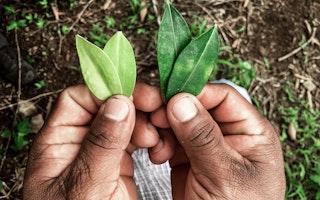Envisioning a New Approach to a Sacred Mexican Plant
By Nicholas Spiers & Litay Ortega

The verdant and fertile mountains of Mexico’s Sierra Mazateca region are home to a great variety of psychotropic plants and fungi, which have long been instrumental in many of the Mazatec people’s unique magico–religious and medicinal practices. Salvia divinorum, a plant containing the most potent nonartificial psychoactive compound known to date, is one of the most revered. Classified botanically in 1962, it is found naturally only in this small, relatively isolated corner of the world.
La xka Pastora, as the plant is commonly known among the Mazatec, is used in veladas, nocturnal ceremonies guided by experienced chjota chjiné (he/she who knows), to help resolve specific problems. These can include serious illness, familial ruptures, social discord, and even unwelcome supernatural encounters.
Traditionally, the fresh leaves are either chewed or their juices extracted and consumed in beverages. Effects may last for up to three hours and are said to facilitate revelations usually concealed from normal states of consciousness in which the sentient, anthropomorphized figure of the plant itself often features.
Today, however, the plant has come to be known around the world for the concentrated extracts that are smoked to produce short-lived, powerful psychotropic effects. This application has earned a degree of notoriety through homemade YouTube videos depicting the bizarre and sometimes disturbing results of young people’s experimentations.
Sensationalist media and prohibitionist politicians have seized on these images to further drug policies that criminalize the plant, succeeding in a number of countries and several U.S. states. But in its native Mexico, the plant remains legal despite poorly informed and sometimes falsely stated arguments for prohibition that have largely ignored or underplayed the plant’s importance for the Mazatec.
Nontraditional approaches to the plant are more nuanced than the YouTube phenomenon would suggest, and a growing band of Salvia enthusiasts around the world are also experimenting with the eating of fresh leaves. Dale Pendell, a celebrated poet and ethnobotanist, coined the term “the path of leaves and the bridge of smoke” to characterize the two very different forms of consuming Salvia divinorum. He claims the bridge of smoke (smoking the extract) doesn’t allow the true benefits of the plant to be reaped, unlike the more traditional path of leaves. Similarly, Daniel Siebert, the creator of the Salvia divinorum Research & Information Centre, looks to the historical Mazatec use of the plant “as a (more) constructive tool for gaining insight and for healing.”
Agua de Rayo, a nonprofit platform for ethnographic research and creation, has developed a series of short films to present these different perspectives and offer a broader, more nuanced picture of Salvia divinorum. The videos challenge uninformed caricatures of the plant and trace its complicated journey to the present day. Recent research, for example, has shown promising applications in the treatment of addiction, inflammation, headaches, gastrointestinal problems, depression, and mental disorders such as schizophrenia.
The medicinal properties of Salvia divinorum are of course nothing new for the Mazatec, who have also long used la Pastora for its nonpsychoactive properties. However, embrace of the plant outside the Sierra as a smokeable extract for recreational purposes is virtually unheard of.
When this phenomenon arose in the mid-2000s, outside traders of the plant naturally looked to the Mazatec to supply this burgeoning market. However, these traders have since largely abandoned the region, having appropriated cultivation of the plant in areas outside the Sierra. This has denied many already economically precarious Mazatec communities an important source of income.
The commodification of the plant, along with many other socioeconomic stresses affecting the region, has led to a questioning by the Mazatec of the cultural manifestations informing their identity. The place and nature of la Pastora are undergoing a transformation, which has prompted some to decry the plant’s diminishing power and purity.
With this series of short films, we hope to explore these changing dynamics to engender a more nuanced dialogue around the commercialization of sacred plants. Our aim is to inspire more constructive approaches to Salvia and question the prohibitionist dogma that would deny to so many the benefits of this unique plant.
Agua de Rayo is a grantee of the Open Society Foundations.
Watch the first in the three-part series on Salvia divinorum.
Nicholas Spiers is the cofounder of Agua de Rayo, a multimedia platform for ethnographic creation and community development.
Litay Ortega is the cofounder of Agua de Rayo, a multimedia platform for ethnographic creation and community development.

